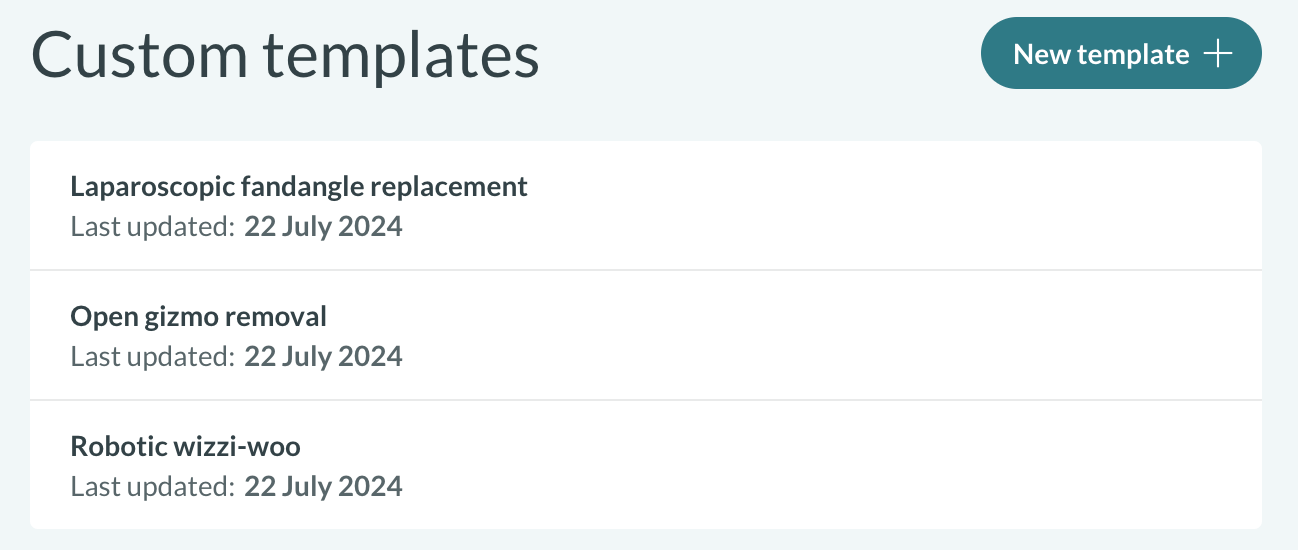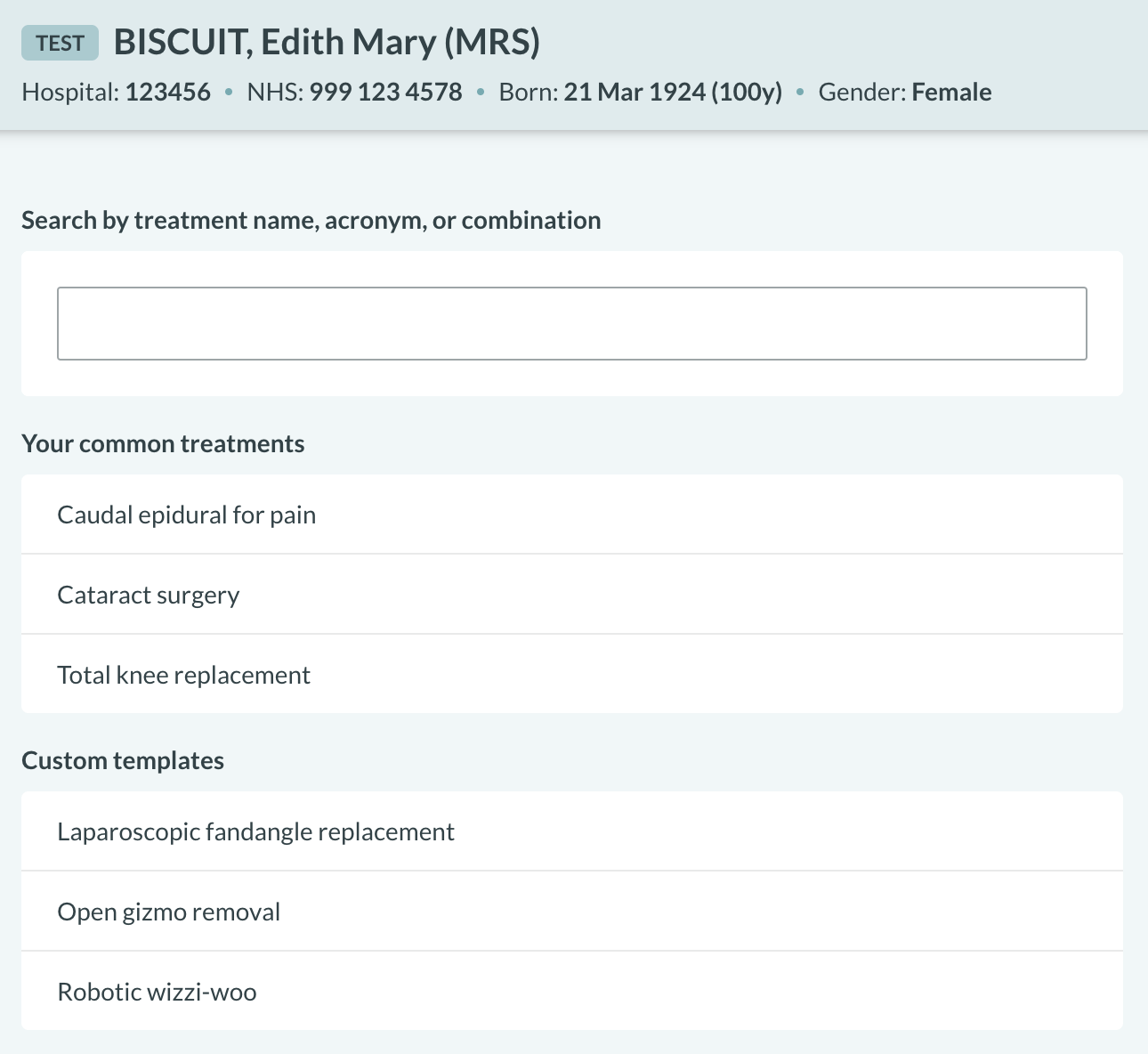Custom templates
This page provides an overview of our Custom templates feature, explaining what they are, when to use them, and the workflows involved.
What are custom templates?
Custom templates enable individuals to save and reuse their own templates and share them with colleagues. A custom template may be:
- An entirely new template for a procedure or treatment not yet in the main Concentric library, or
- A version of an existing Concentric template with particular edits, such as changes to wording, risks listed, or other personal or local adaptations.
When should custom templates be used?
Custom templates are useful in two scenarios:
- as a temporary measure for addressing content gaps and/or the need for organisation-wide modifications to existing Concentric templates, and
- for long-term modification of a Concentric template at an individual clinician level.
Addressing content gaps and organisation-wide modifications
Whilst Concentric’s library of templates is the most comprehensive of its kind, some gaps remain, and new templates become necessary over time as clinical practice evolves. Equally, whilst the vast majority of organisations use Concentric’s core version of each template, there are scenarios where an organisation wishes to modify a Concentric template.
In these scenarios, we would always encourage an organisation to submit requests for new templates and modifications to existing templates (read about our content request process here). However, due to the number of organisations we work with, and the quality process we follow for content updates, requests can take several months for our team of clinicians to action. Custom templates enable an organisation to quickly ensure that an appropriate template is availabile while awaiting an update to the main Concentric library. One clinician within the organisation can create or modify a template and then share it with relevant colleagues.
Modification of a template for an individual clinician
Clinicians are responsible for ensuring that consent information is appropriate for their practice and, at the consent episode level, for each patient. Custom templates enable a clinician to adjust a Concentric template when clinically justified, for example, to incorporate individual surgeon outcome data.
Video guide
Below is a training video on using custom templates within Concentric, explaining how to create, save, and update your own consent templates, as well as how to use a custom template to create a consent episode.
This video is due for an update, following release 94, which introduced the ability to share custom templates. In the meantime, the following information is supplementary to the video, outlining the process for sharing a custom template and adding a shared custom template:
Sharing a custom template
To share a custom template with colleagues in the same organisation, open the template, click ‘Share’ within the floating footer, and send the URL.

Only the original author can edit a shared template, and any edits made are automatically applied for all users of the template. Similarly, if the author deletes the template, it will be removed for everyone.
In the scenario where the author’s account is disabled (for example, a resident doctor moving to another NHS Trust), the template remains active but can no longer be edited. Given this, although a shared custom template is intended as a temporary measure, it is worth considering whether a permanent member of staff should author it.
Adding a shared custom template
To add a custom template that has been shared with you, open the link and click ‘Add to my templates’ within the floating footer.

The added template will then be displayed in the ‘Shared with me’ section of your list of custom templates.

Both templates created by you and shared with you are shown together within the ‘Custom templates’ section when creating a consent episode.

Important notes regarding custom templates
- A custom template does not benefit from the review and continuous improvement process that applies to the core Concentric templates. This consideration is particularly relevant where a custom template is used on a long-term basis.
- ’Additional consents’ are linked consent modules completed alongside the primary treatment consent (e.g. consent for blood transfusion or a national registry). Additional consents cannot currently be configured within a custom template. Therefore, where relevant, clinicians must manually add them within each consent episode created from a custom template. An info banner is displayed to remind clinicians of this limitation, both within the custom template and in relevant consent episodes.
- Custom templates created from blank currently use the default list of patient consent statements. This list is most appropriate for operations and procedures, rather than for treatments that do not involve an anaesthetic, medicines, etc. In these cases, it may be more appropriate to submit a content request and wait for it to be actioned, rather than use a custom template in the interim.
What future improvements are we planning?
Since the initial introduction of Custom templates in 2024, we have delivered iterative improvements to the feature in response to clinician feedback. Further improvements are planned and we remain keen to hear feedback to help us prioritise appropriately.
Iterations delivered include:
- Allowing custom templates to be created from an existing Concentric template, in release 86, and
- Sharing custom templates, in release 94.
Future improvements planned include:
- Configuring additional consents on a custom template (see point 2 above)
- Improved patient consent statement flexibility within custom templates created from blank (see point 3 above)
We welcome your feedback; please share it via the ‘Give feedback’ link within the application or via the contact page. Thank you!